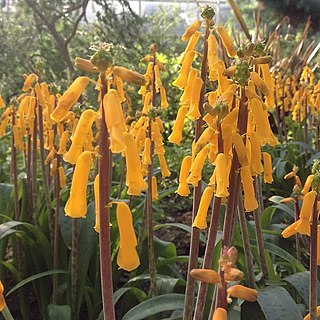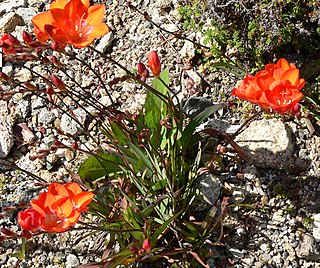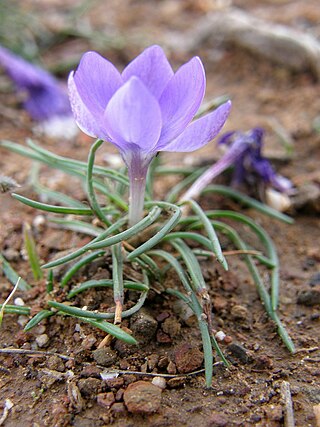
Freesia is a genus of herbaceous perennial flowering plants in the family Iridaceae, first described as a genus in 1866 by Christian Friedrich Ecklon (1886) and named after the German botanist and medical practitioner, Friedrich Freese (1795-1876). It is native to the eastern side of southern Africa, from Kenya south to South Africa, most species being found in Cape Provinces. Species of the former genus Anomatheca are now included in Freesia. The plants commonly known as "freesias", with fragrant funnel-shaped flowers, are cultivated hybrids of a number of Freesia species. Some other species are also grown as ornamental plants.

Gladiolus is a genus of perennial cormous flowering plants in the iris family (Iridaceae).

Ixia is a genus of cormous plants native to South Africa from the family Iridaceae. Some of them are known as the corn lily. Some distinctive traits include sword-like leaves and long wiry stems with star-shaped flowers. It usually prefers well-drained soil. The popular corn lily has specific, not very intense fragrance. It is often visited by many insects such as bees. The Ixia are also used sometimes as ornamental plants. The genus is endemic to the Cape Provinces of western South Africa.

Ferraria is a genus of monocotyledonous flowering plants in the family Iridaceae, native to tropical and southern Africa. They are herbaceous corm-bearing plants growing to 30–45 cm tall. Some species have an unpleasant scent similar to rotting meat and are pollinated by flies, while others have a pleasant scent. The genus name is a tribute to Italian Jesuit Botanist and botanical artist Giovanni Baptista Ferrari.

Lachenalia is a genus of bulbous perennial plants in the family Asparagaceae, subfamily Scilloideae, which are usually found in Namibia and South Africa. Most of them have a dormancy period, but new roots will always grow every year.

Tritonia is a genus of flowering plants in the iris family first described as a genus in 1802. They are naturally distributed across southern Africa, with a high concentration of species in Cape Province of western South Africa. The genus is closely related to the genus Ixia.

Moraea, the Cape tulips, is a genus of plants in the family Iridaceae, first described as a genus in 1758. The group is widespread across Africa, the Mediterranean, and central and southwestern Asia. The genus name is a tribute to the English botanist Robert More.

Aristea is a genus of evergreen, perennial and rhizomatous species of flowering plants in the family Iridaceae, first described in 1789. The genus is distributed in tropical and southern Africa, as well as Madagascar. The genus name is derived from the Greek word arista, meaning "awn".

Hesperantha is a genus of cormous flowering plants in the family Iridaceae. The genus name is derived from the Greek words hesperos, meaning "evening", and anthos, meaning "flower".

Syringodea is a genus of flowering plants in the family Iridaceae, first described as a genus in 1873. The entire genus is endemic to South Africa.

Thereianthus is a genus of flowering plants in the family Iridaceae, first described as a genus in 1941. The entire genus is endemic to Cape Province in South Africa.

Tritoniopsis is a genus of flowering plants in the family Iridaceae, first described as a genus in 1926. The entire genus is endemic to Cape Province in South Africa. The genus name refers to the African genus Tritonia and is combined with the Greek word opsis, meaning "look-alike".

Miriam Phoebe de Vos was a leading South African botanist and academic. She was an expert on bulbous plants, especially Romulea. She also had a special interest in Moraea and Clivia.

Drimia is a genus of African, south European and south Asian flowering plants. In the APG IV classification system, it is placed in the family Asparagaceae, subfamily Scilloideae. When broadly circumscribed, the genus includes a number of other genera previously treated separately, including Litanthus, Rhodocodon, Schizobasis and Urginea.

Lapeirousia is a genus in the plant family Iridaceae. It is endemic to sub-Saharan Africa, about a third of the species occurring in fynbos.

Romulea sabulosa is a perennial geophyte that is assigned to the family Iridaceae. It has a few grooved thread-like leaves, and relatively large burgundy red trimerous flowers, reminiscent of crocus flowers, with yellow to light greenish with black markings and stamens with light green free filaments. It only occurs on sandy clay on renosterveld west of Nieuwoudtville in the Northern Cape province South Africa. It is called satynblom in Afrikaans.

Romulea tortuosa is a herbaceous perennial geophyte in the family Iridaceae native to South Africa. It has a small corm in the soil, a few prostrate coiling leaves, and fragrant, trimerous yellow flowers, sometimes with six brown blotches on the inside near the bottom of the flower.

Romulea monadelpha is a herbaceous perennial geophyte in the family Iridaceae native to South Africa. It has a small corm in the soil, a few thread-like leaves, and trimerous dark red flowers with elaborate markings on the inside near the bottom of the flower. It is called karoo satynblom in Afrikaans.
Afrosolen is a genus of flowering plants belonging to the family Iridaceae.



















